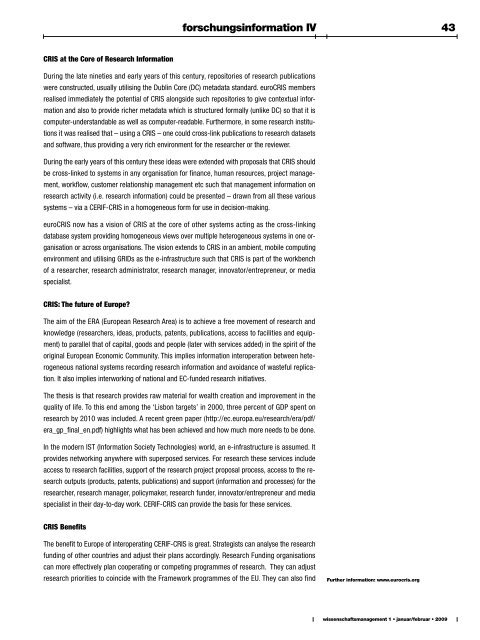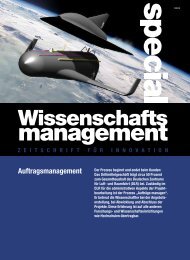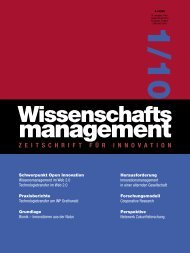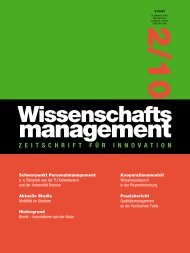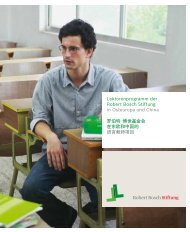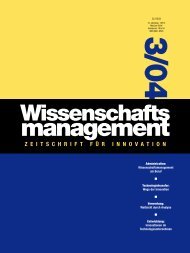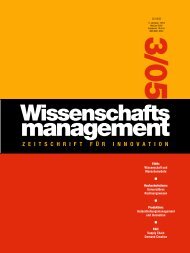Z e i t s c h r i f t f ü r i n n o v a t i o n - Lemmens Medien Gmbh
Z e i t s c h r i f t f ü r i n n o v a t i o n - Lemmens Medien Gmbh
Z e i t s c h r i f t f ü r i n n o v a t i o n - Lemmens Medien Gmbh
Sie wollen auch ein ePaper? Erhöhen Sie die Reichweite Ihrer Titel.
YUMPU macht aus Druck-PDFs automatisch weboptimierte ePaper, die Google liebt.
CRIS at the Core of Research Information<br />
During the late nineties and early years of this century, repositories of research publications<br />
were constructed, usually utilising the Dublin Core (DC) metadata standard. euroCRIS members<br />
realised immediately the potential of CRIS alongside such repositories to give contextual information<br />
and also to provide richer metadata which is structured formally (unlike DC) so that it is<br />
computer-understandable as well as computer-readable. Furthermore, in some research institutions<br />
it was realised that – using a CRIS – one could cross-link publications to research datasets<br />
and software, thus providing a very rich environment for the researcher or the reviewer.<br />
During the early years of this century these ideas were extended with proposals that CRIS should<br />
be cross-linked to systems in any organisation for finance, human resources, project management,<br />
workflow, customer relationship management etc such that management information on<br />
research activity (i.e. research information) could be presented – drawn from all these various<br />
systems – via a CERIF-CRIS in a homogeneous form for use in decision-making.<br />
euroCRIS now has a vision of CRIS at the core of other systems acting as the cross-linking<br />
database system providing homogeneous views over multiple heterogeneous systems in one organisation<br />
or across organisations. The vision extends to CRIS in an ambient, mobile computing<br />
environment and utilising GRIDs as the e-infrastructure such that CRIS is part of the workbench<br />
of a researcher, research administrator, research manager, innovator/entrepreneur, or media<br />
specialist.<br />
CRIS: The future of Europe?<br />
The aim of the ERA (European Research Area) is to achieve a free movement of research and<br />
knowledge (researchers, ideas, products, patents, publications, access to facilities and equipment)<br />
to parallel that of capital, goods and people (later with services added) in the spirit of the<br />
original European Economic Community. This implies information interoperation between heterogeneous<br />
national systems recording research information and avoidance of wasteful replication.<br />
It also implies interworking of national and EC-funded research initiatives.<br />
The thesis is that research provides raw material for wealth creation and improvement in the<br />
quality of life. To this end among the ‘Lisbon targets’ in 2000, three percent of GDP spent on<br />
research by 2010 was included. A recent green paper (http://ec.europa.eu/research/era/pdf/<br />
era_gp_final_en.pdf) highlights what has been achieved and how much more needs to be done.<br />
In the modern IST (Information Society Technologies) world, an e-infrastructure is assumed. It<br />
provides networking anywhere with superposed services. For research these services include<br />
access to research facilities, support of the research project proposal process, access to the research<br />
outputs (products, patents, publications) and support (information and processes) for the<br />
researcher, research manager, policymaker, research funder, innovator/entrepreneur and media<br />
specialist in their day-to-day work. CERIF-CRIS can provide the basis for these services.<br />
CRIS Benefits<br />
The benefit to Europe of interoperating CERIF-CRIS is great. Strategists can analyse the research<br />
funding of other countries and adjust their plans accordingly. Research Funding organisations<br />
can more effectively plan cooperating or competing programmes of research. They can adjust<br />
research priorities to coincide with the Framework programmes of the EU. They can also find<br />
forschungsinformation IV 43<br />
Further information: www.eurocris.org<br />
wissenschaftsmanagement 1 • januar/februar • 2009


